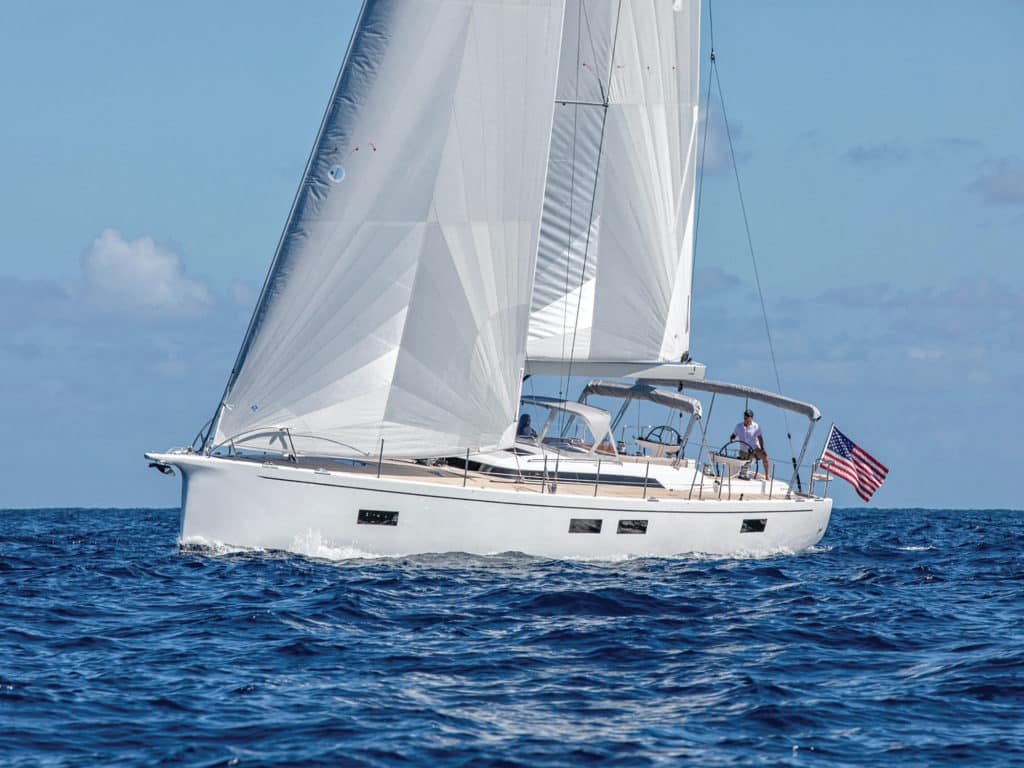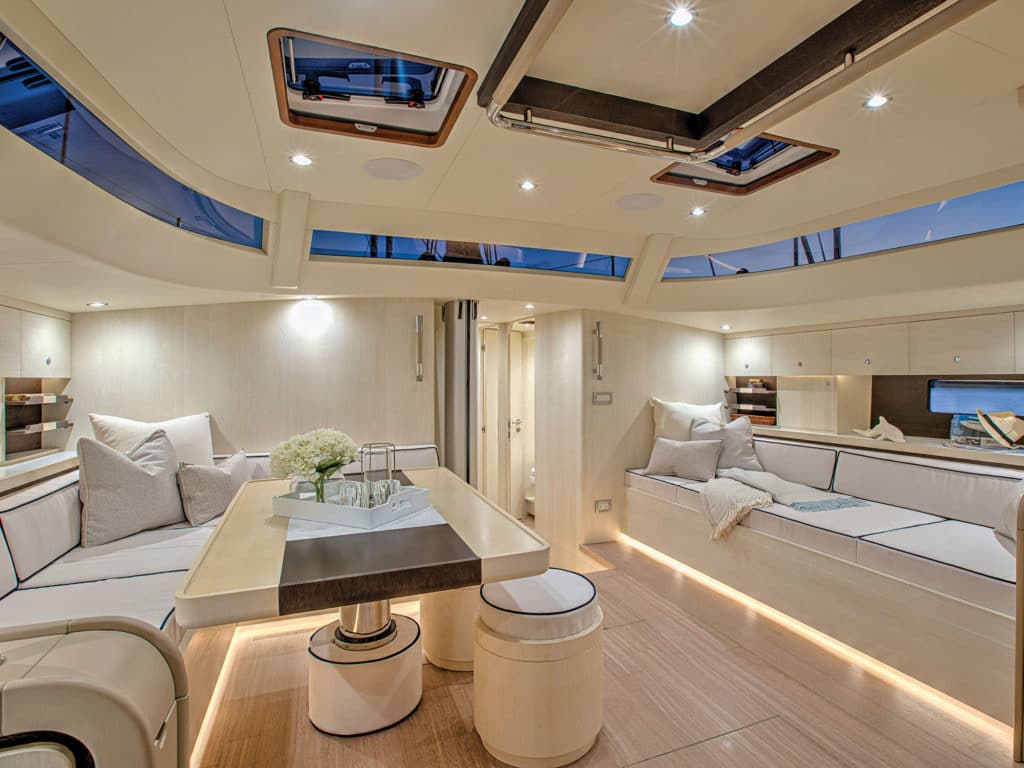
When a new generation took the helm at Hylas Yachts a couple of years ago, it appeared at first that it would be business as usual for the long-standing brand. That business has been the building of finely crafted bluewater-capable center-cockpit cruising yachts, designed by Germán Frers and built by the craftsmen at Queen Long Marine in Taiwan. After all, the first model launched by the latest family members in the proverbial corner office—Andy Huang is CEO, and his sister, Peggy, is COO—was the Hylas 48, named CW’s 2019 Boat of the Year winner in the Full-Size Cruiser Under 48 Feet category. A lovely boat to sail, it shared the solent rig, exterior styling and rich teak interior of its siblings.
But with the introduction of the jaw-dropping H60 this past winter, the Hylas team made it abundantly clear that they are ready to entertain fresh ideas about what sort of sailboat might fit the bill for skippers contemplating long-range adventures.
This time around, Frers drew a hull that’s fully contemporary in its looks, from the sprit on the bow for flying downwind sails to a sleek, low-profile cabin top and a hybrid cockpit arrangement that provides plenty of room to lounge up toward the center of the boat, and twin wheels far aft, where all the actual sailing takes place.
Between those wheels sits a massive Antal electric winch for controlling the mainsail, and four smaller electric winches for handling sheets and assorted running rigging for the self-tacking jib and 105 percent genoa, arranged cutter-style. Here, an owner who takes sail trim seriously has all the tools necessary to push the boat into high gear. Or a skipper and guest can choose instead to kick back on couches to either side of the spacious cockpit table and let captain and crew push the buttons and drive. It’s good to have options.
But by far the biggest surprise—and I mean that in a wonderful way—came when I stepped below to find myself surrounded by an interior that is a study in shades of white: white ash furniture, white leather fabric overhead, white meganite acrylic counters and a light-colored sole, and all of it set off with just the right amount of dark African wenge accents to make it all pop. Interior design is by Hot Lab. “Wow” is the first word that came to mind as I scribbled in my notebook.
In an interview this spring, Andy Huang said that by design, the H60 is intended for a certain group of sailors. “It is very attractive in terms of the look, performance, deck setup and lifestyle aboard. It will be the luxury, performance and modern model for the Hylas range.”
That said, the actual layout of the H60 is fairly traditional for a passagemaker. Starting far forward, there’s a VIP cabin just aft of a watertight crash bulkhead that features an island queen and a pair of hanging lockers. This cabin shares a head that’s aft to starboard, with a second guest cabin with bunks to port.
The saloon sole is raised and provides room for tankage beneath to keep weight low in the boat. With 370 gallons of fuel, 391 of water and a watermaker, the boat’s equipped for the long haul.
There’s a proper rear-facing nav station to port at the foot of the companionway, with walk-in access to the engine room farther aft. A large dining table, surrounded by an L-shaped outboard couch and padded stools on the centerline, occupies the port side of the saloon, and there’s a second large couch to starboard.
An efficient-looking and well-equipped galley, with tons of counterspace and cupboards for stowing provisions, is located in the starboard passageway to the aft owner’s cabin.
And the aforementioned en suite aft cabin? Well, that earned another underlined “wow” in the notebook. The space feels huge, with a couch to starboard, desk to port and a spacious berth in between.
The H60 is also available in a four-cabin configuration, which splits this space into two cabins, each with twin single berths. In this arrangement, the owners get the VIP quarters up front.

Besides its modern look, the H60 introduces several new construction methods that the yard has incorporated. Previously, hulls, decks and other parts have all been hand-laid at the Queen Long yard. The H60′s Divinycell-cored hull, deck and bulkheads were instead infused at the nearby Atech Composites, specialists in SCRIMP (Seemann Composites Resin Infusion Molding Process) technology. Hylas says the result is a hull that’s 8 percent lighter and 40 percent stronger. The hull and deck were then shipped back to Queen Long for the build-out. Other innovations include twin rudders, a CZone electrical system, Seldén hydraulic in-mast furling for the main and Seldén electric furlers for the headsails. Base price for the boat is $1.85 million, but hull No. 1, adorned with bells and whistles, carried about $380,000 in upgrades, including North NPL sails.
As I mentioned, the H60 was designed and built to be a long-range cruiser, so our test sail following the Miami International Boat Show was a bit unusual. Rather than long tacks and reaches along South Beach, we instead found ourselves short-tacking up and down the channel alongside Port of Miami piers. But ironically, this proved to be a good thing because it kept us on our toes as we ricocheted between the shallows to one side, ships on the other, and considerable traffic in between. The breeze was light, so we kept the staysail furled and used the genoa instead. In 12 or so knots of wind, our speed over ground was a little better than 6 knots, and we were still making 5 knots when the breeze dipped below 8. Handling was effortless in these conditions, thanks to Jefa Steering, and I found it easy to bounce between wheels when coming about. Placement of the winches kept lines close at hand. My one (minor) gripe while sailing was that the Bimini restricted the view of the mainsail, but then again, I wasn’t complaining about the hot sun, and the awning can be rolled back.
In launching this latest model, Hylas decided to go after sailors who are looking for something new and different but not at the expense of seakindliness and performance. In that regard, the H60 sure worked for me.
Mark Pillsbury is CW’s editor.
SPECIFICATIONS
| LENGTH OVERALL | 59’9″ (18.21 m) |
|---|---|
| WATERLINE LENGTH | 54’9″ (16.69 m) |
| BEAM | 17’3″ (5.26 m) |
| DRAFT (Std./Shoal) | 8’10″/6’6″ (2.69/1.98 m) |
| SAIL AREA (100%) | 1,827 sq. ft. (169.7 sq. m) |
| BALLAST (Std./Shoal) | 22,562/24,972 lb. (10,234/11,327 kg) |
| DISPLACEMENT | 37,397 lb. (16,963 kg) |
| BALLAST/DISPLACEMENT (Std./Shoal) | 0.35/0.38 |
| DISPLACEMENT/LENGTH | 178 |
| SAIL AREA/DISPLACEMENT | 18 |
| WATER | 391 gal. (1,480 L) |
| FUEL | 370 gal. (1,400 L) |
| HOLDING | 40 gal. (151 L) |
| MAST HEIGHT | 91’6″ (27.89 m) |
| ENGINE | 150 hp Volvo, Shaft Drive |
| DESIGNER | Germán Frers, Interior by Hot Lab |
| PRICE | $2,230,000 |
Sea Trial
| WIND SPEED | 8 to 12 knots |
|---|---|
| SEA STATE | Calm |
| SAILING | Closehauled 6.2 knots, Reaching 5 knots |
| MOTORING | Cruise (2,200 rpm) 7.3 knots, Fast (2,950 rpm) 9 knots |
Hylas Yachts
561-515-6027








